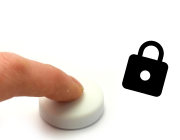
Bluetooth LE Security and Access Control
When you apply power to an Espruino device, it'll start up, and will be connectable (and programmable) by anyone.
Much like many other development devices, this is done so you can get up and running quickly, without the hurdle of having to enter passwords.
However as soon as you want to use Espruino properly, you will almost certainly want to lock it down so that it can't be programmed by other people.
Note: While unbonded (see the end of this page) Bluetooth communications are unencrypted - so you should be aware that someone within range with bluetooth sniffing hardware could conceivably view anything written or uploaded to Espruino.
There are a few options:
Don't allow connections to Espruino
With NRF.setAdvertising
you can allow Espruino to keep transmitting advertising data, but ensure that no
computer can connect to it:
NRF.setAdvertising({}, { connectable:false });
Add a password with E.setPassword("password")
See here. This will keep the UART service and allow any computer to connect to Espruino, but will require anyone connecting to enter a password to access the Espruino Console.
This isn't perfect as it still allows anyone to connect, just not to access the JavaScript prompt.
'Hide' the console device
Using a command like LoopbackA.setConsole(true) you can force the JavaScript
console into Loopback.
This means it will only be accessible via reads and writes to the LoopbackB
variable. If someone connects to Espruino they will still get access to the UART,
but will be unable to do anything.
Anything written to the Bluetooth UART will still be available on the Bluetooth
variable via Bluetooth.on('data', function(data) { ... }) and you can write
responses with Bluetooth.write(...).
Note: you will no longer be able to program the Puck until you reset it
or programatically call Bluetooth.setConsole().
Note: it's also possible to totally disable the console with E.setConsole(null,{force:true})
Disconnect when an unknown address is found (whitelisting)
You can easily hook onto the connect event, and then force a disconnect if
it is from an unknown address.
NRF.on('connect',function(addr) {
if (addr!="69:2d:94:d0:9d:97 public")
NRF.disconnect();
});
Other Espruino devices will tend to have an address of the form "aa:bb:cc:dd:ee:ff random",
but PCs and phones will generally have the form "aa:bb:cc:dd:ee:ff public"
To find out which MAC address to use, you can upload this code:
devices = [];
NRF.on('connect',function(addr) {
devices.push(addr);
});
// now connect a few times and see what's in 'devices' using the left-hand side
NOTE: iOS and New versions of Android can perform 'MAC randomisation' where they use a random MAC address each time they connect. In those cases, on firmware 2v19 and later you can use NRF.resolveAddress(addr) to attempt to look up the non-random address (if the device is bonded).
NOTE: MAC addresses can be modified so this is not 100% secure. However the chances of someone guessing the correct MAC address without being in the area to snoop on a connection while it is active are extemely low.
Disable the BLE UART
If you don't need the user to be able to access the BLE UART, we'd suggest
totally disabling it with NRF.setServices
NRF.setServices(undefined, {
uart : false
});
This will completely remove the UART service, making Espruino unprogrammable until it is reset.
Calling NRF.setServices again with uart:true will re-add the service. For
instance the following code will disable or enable the UART (as well as flashing
the red or green LEDs) when the button is pressed.
var locked = true;
NRF.setServices(undefined,{uart:!locked});
setWatch(function() {
locked = !locked;
digitalPulse(locked?LED1:LED2,1,100);
NRF.setServices(undefined,{uart:!locked});
}, BTN, {repeat:true, edge:"rising", debounce:50});
Disable Bluetooth
You can call NRF.sleep() and
NRF.wake() to turn Bluetooth
off or on.
This will stop the device from advertising its presence, and will make it unconnectable by anyone - however it does increase the battery life.
The following code flashes the red or green LED and turns Bluetooth on or off.
var locked = false;
setWatch(function() {
locked = !locked;
digitalPulse(locked?LED1:LED2,1,100);
if (locked) NRF.sleep();
else NRF.wake();
}, BTN, {repeat:true, edge:"rising", debounce:50});
Bonding / Whitelisting
As of Espruino 1v92, Bonding is implemented in Espruino. When devices are bonded they will be able to establish secure communications with each other.
Espruino will accept secure or insecure connections - it is up to the
connecting device to initiate the bonding procedure. If
NRF.setWhitelist(true) has been called, when a device is next
bonded to Espruino, it will be added to the whitelist and the whitelist
will be enabled - stopping other devices from connecting until
Espruino is restarted with the button held down.
Espruino can also handle secure connections and bonding when it connects to other
devices. Once connected, you can initiate the bonding procedure with the
startBonding
method, and can check the status of the connection with
getSecurityStatus.
It's also possible to force bonding as soon as a device attempts to access the
Bluetooth UART. You can do this with NRF.setSecurity({encryptUart:1});
Passkey/Pin pairing
As of Espruino 2v02, you can set a static Passkey for Espruino:
NRF.setSecurity({passkey:"123456", mitm:1, display:1});
When connecting, the central device will then request a passkey, and
the connection will fail if 123456 isn't entered.
As of 2v19 you can also display a PIN that the connecting device provides. For instance with the following:
NRF.setSecurity({mitm:1, display:1});
NRF.on("passkey", key => print("Enter PIN: ", key));
The bonding will then only succeed if you enter the PIN number on the connecting device that Espruino has displayed.
Note: When Espruino is acting as central connecting to another device you can
enter a passkey using the BluetoothDevice.passkeyRequest event and
BluetoothDevice.sendPasskey method (as long as NRF.setSecurity
contains keyboard:1). This isn't implemented for peripheral mode yet.
Disabling bonding of new devices
As of Espruino 2v19, once you have a device paired with NRF.setSecurity({mitm:1, ...}); above,
you can use pair:false to disallow new devices from pairing, which will effectively whitelist
connections to the device to just those devices that have paired in the past.
NRF.setSecurity({pair:0,mitm:1});
This page is auto-generated from GitHub. If you see any mistakes or have suggestions, please let us know.